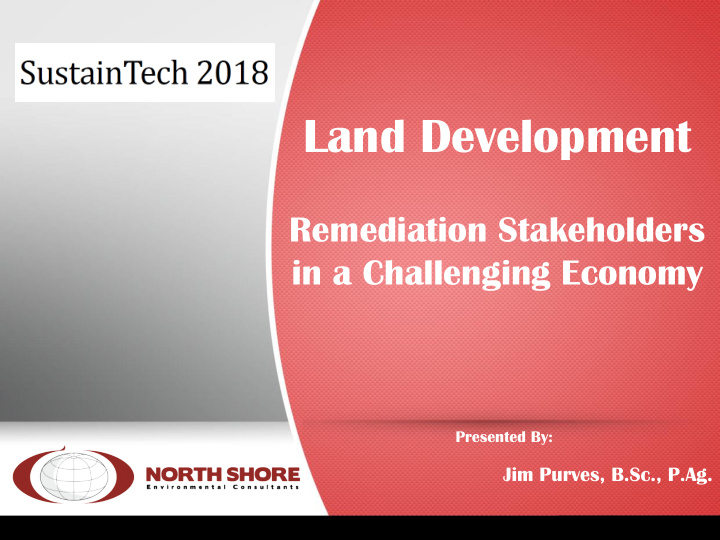



Land Development Remediation Stakeholders in a Challenging Economy Presented By: Jim Purves, B.Sc., P.Ag.
OUTLINE • Former oil and gas activities on traditionally agricultural land are now being re-evaluated as part of development opportunities. • New stakeholders in the to the oil and gas reclamation game. • How the current economic environment is affecting land development?
OUTLINE • Look at urban encroachment examples in Alberta. • Well Closure Language • Liability Gap – Buyer Beware • Examine three case studies in Alberta.
NEW STAKEHOLDERS • Land Development Companies • Financial Institutions • MD and County Representatives • Municipal Planners • Business Owners • Private Landowners
Oil and Gas Activity in Alberta • Alberta Energy Regulator (AER) oversees 449,000 wells that were drilled in the last century • 76,500 inactive • 66,500 abandoned • 104,500 reclaimed
Urban Development Devon, Alberta • Founded in 1947 following the discovery of oil at the Imperial Leduc 1 well
Town of Devon Year Population Oil and Gas Wells within 1 km radius 1950 1000 91 2011 6510 166
Town of Devon
Town of Devon
Town of Devon
Town of Devon
Town of Devon
City of Edmonton, Alberta Year Population Oil and Gas Wells within 1 km radius 1950 148,861 25 2011 1,159,869 480
City of Edmonton, Alberta
City of Edmonton, Alberta
“Former Wellsite Status”
“Former Wellsite Status” Abandoned Well Only means surface abandonment has been completed. Does not address whether the site has been assessed or not. Reclamation Certified But when was the certificate issued? Pre-2001: Requirements focused on surface reclamation and not contamination** Post-2001: Detailed requirements for assessing contamination implemented
Reclamation Exempt Wells that were abandoned prior to reclamation legislation being enacted, known as Reclamation Exempt (Rec Exempt) wells. These are wells that either: a) In the White Area (private land) and were abandoned prior to June 1, 1963 , or b) In the Green Area (Crown land) and were abandoned prior to August 15, 1978. A total of 36,534 Rec Exempt Wells in Alberta Focused on surface reclamation and not contamination
Operator Liability Operators own a lifetime liability on contamination issues Operators own a 25 year liability on reclamation issues Orphan Well Association (OWA) Well, pipeline or facility without any legally responsible or financially able party to deal with it’s abandonment and reclamation
Operator Liability • Stakeholder Engagement • Significant Barriers to Development • Wellbore Setbacks • Sensitive Receptors • Risk Ranking • Active Facilities - Offsite Impact • AER Enforcement Order Impacts Timelines on Reclamation
Liability Gap Reclamation Certified and Reclamation Exempt wells are not covered under OWA. So if your site has a Defunct Operator with No Transfer of Liability • There is no operator to assume liability • Does not fall under OWA
Rec Certified / Rec Exempt Defunct Operator Liability Gap • Liability falls under the current landowner • Buyer Beware Situation • Developers generally complete due diligence (PH1 ESA) • For Agricultural Land Sales – Private Landowners may be unknowingly transferring liability • Government Held Liability on Public Land
Defunct Operator Liability Gap Increased liability associated with: 1) Reclamation Certified prior to 2001 2) Reclamation Exempt Requirements focused on surface reclamation and not contamination
SITE CLOSURE
General Site Closure Remediation Certificate • Program initiated in 2009 • Applies to any site (oils and gas, commercial, industrial, residential) • Relatively simple application • Provides CLOSURE AGAINST CHANGING CRITERIA • Alberta Tier 1 has been revised six times since 2001
Three Development Examples 1) Residential 2) Active Commercial Subdivision 3) New Commercial Subdivision
Case Study #1 Residential Development
Case Study #1 Residential Development
Case Study #2 Active Commercial Development
Case Study #2 Active Commercial Development
Case Study #2 Active Commercial Development
Case Study #3 New Commercial Subdivision
Case Study #3 New Commercial Subdivision
Case Study #3 New Commercial Subdivision
Developer’s Comments Smaller Communities • Allowing for staged utilities development – good incentive • Typically don’t have qualified staff – requires consultant involvement Larger Communities • Require full utilities development up front which can be prohibitive Overall • Construction costs are down • Municipalities should view development as partners vs revenue stream • OWA should really be responsible • Edmonton now requiring groundwater assessments on developments with former oil and gas facilities
CONCLUSIONS Goal is to improve the quality of decisions made by these new stakeholders when evaluating environmental risk associated with their development. Liability Gap – buyer beware, especially for agricultural land sales Equivalent Land Use Capability? - former wellsites are being omitted from development plans Closure timelines amongst stakeholders will be challenging
QUESTIONS?? Jim Purves, B.Sc., P.Ag. Technical Resource Manager jpurves@northshoreenv.com 780-913-6137 www.northshoreenv.com
Recommend
More recommend